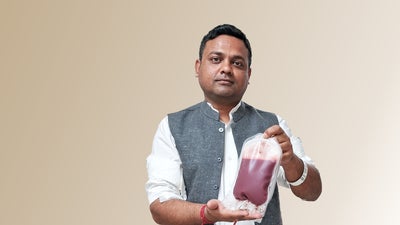DKMS Life Science Lab: 25 Years of Pioneering Innovation
DKMS DONOR TYPING LAB CELEBRATES 25TH ANNIVERSARY
DRESDEN, July 13, 2022 – Every year, hundreds of thousands of samples of potential stem cell donors from all over the world are analyzed in the DKMS Life Science Lab. In recent years, the highly automated laboratory has developed many innovations in-house - always for the benefit of donors and patients. The next self-imposed goal is to type another nine million potential stem cell donors by 2030 and to add them to the diverse DKMS donor file.
For many of the 1.3 million people worldwide who develop blood cancer each year a stem cell transplant is required during the course of their disease. Without this treatment option, many patients would not survive. For every successful transplant however, a matching stem cell donor is needed. DKMS has already registered more than eleven million people as potential donors. A key part of the registration process is donor typing. This is important, because before a donation can be made, certain genetic characteristics must be matched with those of the patient. For DKMS donors, the determination of these genetic markers takes place in the DKMS Life Science Lab.
"Our lab has reached the milestone of its 25th anniversary - a quarter of a century that has seen many changes and innovations in genotyping and stem cell donor profiling methods. Thanks to our experts, the DKMS Life Science Lab has continued to evolve. We use state-of-the-art technologies in innovative ways to be able to type more donors in better quality," said Dr. Alexander Schmidt, Chief Executive Officer of DKMS Life Science Lab, at the anniversary press conference. "Today, we look back with pride on what our lab, together with its dedicated staff, has achieved over the past 25 years."
The more accurate the typing - the better the "match"
The DKMS Life Science Lab operates in the heart of Dresden. It handles the analysis of all donor samples from the DKMS donor files from seven countries across five continents. The most important markers examined in the course of typing are the human leukocyte antigen (HLA) characteristics. These are structures on the surface of cells that signal to the body whether they are its own or foreign "material". To prevent rejection reactions during stem cell transplantation, the HLA characteristics of the patient and donor must match as closely as possible. "Currently, people usually match 12 HLA characteristics for a stem cell transplant - yet, unfortunately, post-transplant complications resulting from an imperfect donor-patient match are still common. Therefore, together with the Collaborative Biobank and the Clinical Trials Unit of DKMS, as well as other scientists, we are actively doing research to identify additional genetic markers with influence on transplant success. We have already expanded the typing profile of DKMS donors to include genetic markers within and outside the HLA system, so that all parameters relevant to the donor search are available in advance. This makes it quicker and easier to check whether a donor is a possible "match" for a patient," said Dr. Vinzenz Lange, Chief Technology Officer of the DKMS Life Science Lab.
Innovation highlights from the lab's daily routine
At the DKMS Life Science Lab, several 100,000 donor samples are typed in high resolution each year - making it one of the largest typing laboratories in the world. This immense throughput could only be achieved by completely converting the lab to a technology that was still quite new at the time in 2013: Next-Generation Sequencing. This made the Life Science Lab the first typing laboratory to introduce this technology for high-throughput HLA typing. With this measure, the laboratory capacities could be increased more than eightfold.
Another highlight is the in-house development of a cytomegalovirus (CMV) antibody test that does not require blood sampling, rather only a swab of the buccal mucosa. At DKMS, CMV status is part of the typing profile because it is important for donor selection. Since 2017, the laboratory tests the CMV status via an uncomplicated cheek swab directly during registration. This makes the donor search process faster and the associated time savings can be vital for patients urgently awaiting a transplant.
The lab's latest development has only been in operation since the beginning of the year. The “Swabster” automates the important first step of donor typing. The highly precise and globally unique robot places the cheek swabs of the donors into the specified well on a test tray and reliably removes the stem from the head of the swab. This perfectly prepares the molecular biological analysis of the samples.
20 million DKMS donors by 2030
These kinds of innovations enable simple, efficient, and cost-effective typing, thus helping to include as many donors with high-resolution data as possible in the file. Today, the DKMS share of unrelated stem cell donations worldwide is 35 percent. Since its foundation in 1991, DKMS has given more than 100,000 people a second chance at life. The non-profit organization has ambitious plans for the future. "Every day, thousands of samples from all over the world are analyzed at our laboratory using the highest standards of science and technology. Thus, the laboratory makes an indispensable contribution to our international DKMS donor files," said Dr. Alexander Schmidt. The goal of DKMS is to include 20 million potential DKMS donors in the DKMS Registry by 2030 in order to give even more people with blood cancer a second chance at life. "With the DKMS Life Science Lab at our side, we will realize this goal," Dr. Schmidt emphasized.


